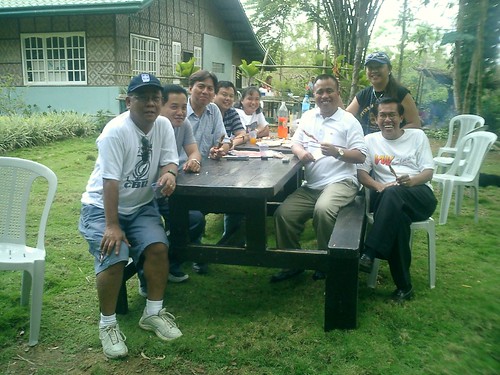The Long View : Convened and reconvened?
Manuel L. Quezon III
Inquirer News Service
ON JAN. 7 and 8, 1984, the Congress of the Filipino People (Kompil) was held to address a pressing issue: What course of action should the opposition take with regard to the upcoming Batasan elections? Everyone said their piece, including Jose Ma. Sison who sent a message.
Joma advocated boycotting the elections. Many disagreed. A compromise was painfully reached: participation under certain conditions. The conditions were agreed upon by balloting. The Kompil had succeeded in revealing a way for diverse groups to come up with a common position.
Marcos, of course, rejected the conditions, which caused a flurry of renewed debates among the opposition. Lorenzo Tanada, Jose Diokno and Butz Aquino called for a boycott, citing the same arguments of the 1978 and 1981 boycott movements. The boycott group eventually formed an umbrella organization, CORD, which included former Senators Jovito Salonga and Raul Manglapus and former President Diosdado Macapagal.
Then the widow spoke. Cory Aquino was for participation, even though she had no illusions about the outcome of the polls. In February 1984, Cardinal Sin called for participation, too.
Unido decided to participate in the election, as did the regional parties, such as PDP-Laban, which felt that the boycott campaigns in the past had actually hurt the opposition. Another organization was revived to help guard against fraud: the National Movement for Free Elections. For the first time, the opposition would fight fraud with organized vigilance.
The boycott failed. The turnout was high and, for once, an organized group existed to catalog and inform the public of the government's electoral dirty tricks. The opposition took almost a third of the seats in parliament, after a heavy toll inflicted by the administration's massive cheating.
In the public mind, the opposition had proven its strength. It was time to plan for bigger things. Around the time of the May 14 elections, a Jesuit and businessmen's group began deliberating again on the contingencies should Marcos die. This group called themselves the "Facilitators." They finally decided on a way to find a candidate quickly. They called it the "fast-track system." Its aim: to avoid the inevitable bickering and internecine strife sure to attend the selection of a common presidential candidate should elections be suddenly called.
Emmanuel Soriano, Dr. Alfredo Bengzon, Ricardo Lopa, Fr. Joaquin Bernas, SJ, and Ramon del Rosario Jr., all members of Manindigan!, were the architects of this process. They met with the Convenor Group, composed of Tanada (representing the "left of center"), Jaime Ongpin (representing moderates), and Cory Aquino, the "symbol of unity."
On Nov. 13, 1984, the two groups came up with a list of "potential standard bearers": Butz Aquino, Jose Diokno, Teofisto Guingona, Eva Kalaw, Salvador Laurel, Raul Manglapus, Ramon Mitra, Ambrosio Padilla, Aquilino Pimentel, Rafael Salas and Jovito Salonga. A month later, these people met with the Facilitators and the Convenor Group, and they agreed to sign a Declaration of Unity. Kalaw and Laurel abstained.
Laurel did not sign because of the anti-US bases line in the declaration. He did not think the cause of freedom needed to add to its enemies. He also offered an alternative method for selecting a united opposition's champion, one that sidestepped the cause-oriented groups, relying purely on the politicians. His group called itself the National Unification Committee or NUC.
The Convenor's Group and the potential standard bearers, in an agreement signed on Jan. 2, chose a system in which the potential candidates would chose, by secret balloting and simple majority vote, the standard bearer from among themselves. They committed themselves to look for a more creative method, but in the meantime that would do.
The NUC offered a compromise solution, whereby the cause-oriented groups would be entitled to a 30-percent representation in the convention that would choose the standard bearer. It invited the Convenor's Group to a meeting. The group declined, sending Mitra to read a message politely explaining that it could not abandon the fast-track system.
But the negotiations went on--in time-honored political fashion--with a continuing exchange of proposals and counter-proposals. They came to a tentative agreement on the actual selection of a candidate, save for one loose end: what to do about Manglapus and Salas who were abroad.
But a common position with regard to the US bases remained elusive. The original draft was written by Salonga: the opposition would "comply with the US-RP Military Bases Agreement of 1947--which will expire in 1991, and oppose the continued existence of foreign military facilities in the Philippines. No military bases should thereafter be allowed."
Laurel opposed the draft. He was open to the renewal of the bases agreement, subject to a plebiscite. Diokno was dead-set against recognizing the validity of the bases agreement altogether. And so the debate went on until, finally, on Nov. 21, 1985, an agreement was reached and the platform approved. The bases provision finally read, "Consistent with our rights and duties under international law and the sovereign rights of our people, foreign military bases on Philippine territory must be removed and no foreign military bases shall be thereafter allowed."
The opposition was almost whole. The success of the NUC-Convenor negotiations proved the resilience of the old politicians who would finally agree to anything for the sake of unity and political effectiveness, because ultimately words meant nothing to them. Hence, they would survive into the era and the new political forces would die. In politics, the finicky finish last.







No comments:
Post a Comment